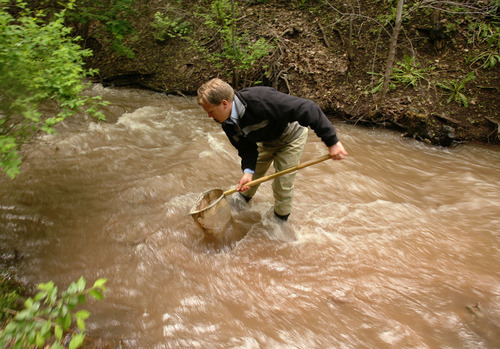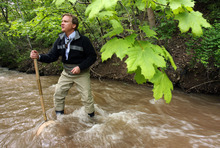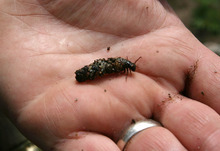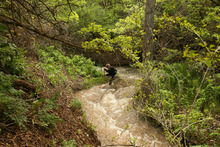This is an archived article that was published on sltrib.com in 2011, and information in the article may be outdated. It is provided only for personal research purposes and may not be reprinted.
Gone is the black slime that oozed eerily through pretty parks and tidy backyards on Salt Lake City's east side. So too are the swarms of workers scrubbing, scooping, suctioning and spray-washing Red Butte Creek.
A year later, Chevron's pipeline burst is history. The spill zone, in many ways, looks like its old self.
But it isn't. To understand why, consider what you don't see — namely, the worms, flies and other creepy crawlies at the low end of the food chain that live at least part of their lives on the stream bottom.
"The bugs are the best barometer," says John Whitehead, assistant director of the Utah Division of Water Quality. "Water and sediment tests have confirmed there is little oil left in the stream. Those are not telling us as much, we think, as the organisms."
Adds Ben Holcomb, the division's bug guru: "Just because you can't see it or smell it doesn't mean there's nothing wrong. The effects of the spill are still visible."
Especially in the missing bugs.
A bug's life • Bob Thompson, a watershed scientist for Salt Lake County, conducted a study of the bugs in Red Butte Creek the fall before last year's spill on June 11 and 12. He found lots of bugs and no signs of chemical pollution.
All signs, he says, pointed to a "reasonably healthy riparian community."
But Whitehead and Holcomb, who went out last week, are finding very different conditions.
At Miller Park, a scenic forest near 1500 East with Red Butte Creek running through its heart, Holcomb steps carefully into the stream — it's running high — and stirs up the bottom with a net.
When he brings it to the shore, he and Whitehead stare inside. They see a few handfuls of BB-size gravel and nothing but a snippet of a worm that seems to be alive.
"That's not a good sign," Holcomb says.
At a second monitoring site near the University of Utah's greenhouses, more than a football field's distance away from where the pipeline broke, the water normally would be teeming with bugs. Instead, Whitehead and Holcomb find a single midge casing.
"Nothing jumping out of the net here," Holcomb says.
Recent findings show some improvement from last June and August, when state water watchers counted fewer than 300 bugs at a site downstream from the spill. Above the spill, they tallied more than 4,500 bugs in June and about 9,500 in August.
It's clear, Whitehead says, that something about the spill is having a lingering effect.
Whitehead wonders if pockets of crude in tiny underwater spaces between rocks remain toxic for the bugs. Another possibility is that the cleaning itself stripped the creek of eggs and other signs of so-called macroinvertebrates.
He points out that many residents wonder why his agency doesn't force Chevron to remove the oil completely by digging up the streambed and replacing everything.
"What we're trying to find here," Whitehead says, "is do we clean up more or do we let the natural alternative work?"
Learning from Alaska • Sue Mauger, a stream ecologist with the Cook Inlet Keeper in Alaska, says finding a balance between scrubbing out the oil and letting nature do it is a delicate question — as experts learned in Alaska in the 22 years since the Exxon Valdez oil spill. Mauger notes that, with crude, "to get that stuff out, you have to blast it out," and that can be hard on living things and their habitat.
"If they [the bugs] haven't come back, that means there's still a problem there," she says. "There's probably another year or two to approach recovery."
A bug-survey site near the spot of the Red Butte spill offers some hope.
Holcomb wades into the grasses and scoops up another net of gravel and small rocks. He points to a restless caddisfly getting ready to shed its pupal case and emerge from the water.
"So we are seeing some life here," says a relieved Whitehead.
Walking her dog into Miller Park, Lisa Long, whose Yalecrest home shoulders Red Butte Creek, stops to listen to Whitehead talk about the spill's lingering impacts. She worries the stream is ruined forever.
"There's no going back in the short term," says Whitehead, reflecting on when the bugs will return. "Maybe not this year. Maybe not next year. There's no quick fix. ... The question is: Can we live with a cleanup that takes three or four years?"
The extra mile • Chevron can provide a long list of what it has done to restore the environment after the 33,600-gallon spill in June and the quickly contained 21,000-gallon spill on Dec. 1.
Company spokesman Mickey Driver, responding to questions via email, notes that all of the work was done under the direction of the Unified Command, a kind of spill SWAT team of federal, state, county and city officials, as well as Chevron personnel.
Crews cleaned debris from the creek, washing affected areas, capturing the crude and disposing of it. They sopped up oil with absorbent booms and pads on Red Butte Creek, Liberty Park's pond and the Jordan River.
Driver notes Chevron even improved the pond (which reopened May 14), replacing the crumbling perimeter ring, rebuilding the boat ramp and installing silt fences.
"At Liberty Park Lake," he says, "we have removed seven years of bird droppings and normal creek sediment fill that totaled to more than 9,000 cubic yards."
But Driver points out more work remains. Crews need to assess the trees and plants along Red Butte Creek and monitor the water and soil long term.
Chevron's goal, he says, is to "fully comply with the applicable regulatory requirements to ensure the continued protection of human health and the environment."
Whitehead says the company will be on call to clean up any oily hot spots along the stream. Plus, there will be state fines on top of the federal ones already issued.
"It's not if," he says, "but what penalties will be appropriate."
Birds by the numbers
John Isanhart, an ecologist with the U.S. Fish and Wildlife Service, says his agency is working with the Environmental Protection Agency to decide what more should be asked of Chevron in light of the 60-plus birds that perished in the Red Butte spill. Here is a tally of that impact:
392
Birds recovered
361
Birds cleaned
328
Birds released
29
Birds dead on arrival
27
Birds that died after the spill
9
Birds euthanized
Source: U.S. Fish and Wildlife Service









